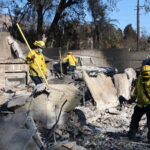Corporate pilots routinely take off without performing required safety checks, a study of thousands of flights by a trade group has found.
Prompted by the 2014 crash of a corporate jet that killed billionaire Lewis Katz, which occurred after pilots neglected to ensure their flight controls worked, the National Business Aviation Association discovered that similar lapses are common.
The group representing corporate flight departments reviewed data from almost 144,000 flights during three years and found that in more than 25,000 cases, or 17.7 percent, pilots failed to complete the same routine check of a plane’s flight controls that doomed Katz and six others on the plane.
“It’s very concerning, a rate that high with professional pilots like these guys are,” Michael Barr, an instructor at the University of Southern California’s Aviation Safety and Security Program, said in an interview. “These aren’t weekend pilots. They are professionals who do it for a living.”
Checking to ensure that a plane’s flight controls work properly is required before all flights. A failure to perform the checklists containing such tests and other safety-critical tasks “is one of the mortal sins of flying,” Barr said.
‘Disturbing’ Findings
The NBAA said in the report, which was undertaken at the request of the U.S. National Transportation Safety Board following its investigation into the Katz crash, that the findings should be used to raise awareness among pilots.
The results were “disturbing” and “the data highlights a lack of professional discipline among some crews in not accomplishing manufacturer-directed checklists – particularly safety-of-flight critical items,” the report said.
“This report should further raise awareness within the business aviation community that complacency and lack of procedural discipline have no place in our profession,” Ed Bolen, president of the Washington-based NBAA, said in comments attached to the report.
A Bloomberg News review last year of business aviation accidents, including both private flights like Katz’s and charter flights, found repeated examples of pilots skipping rudimentary safety checks, working fatiguing schedules and overlooking hazards such as ice on wings.
There were five times more fatal accidents involving high-end corporate jets and turboprops piloted by professional crews from 2000 through 2014 than of passenger airlines, which have many more flights, NTSB records showed. In 2007, deaths from crashes of these planes began to surpass those on passenger airlines – a reversal of the trend stretching back to the dawn of the jet age.
In the May 31, 2014, accident that killed Katz in Bedford, Massachusetts, pilots neglected to release a device known as a gust lock, which holds a plane’s flight controls in place on the ground to prevent damage from winds. The pilots would have known that the controls were locked and the plane couldn’t take off if they had performed a required check, the NTSB found.
The pilots had also failed to complete the checks on all but two of the 176 flights captured on the Gulfstream IV’s flight data recorder, or 99 percent, according to NTSB.
2,923 Flights
The NBAA reviewed flight data captured on 379 corporate aircraft from 2013 through 2015. In 2,923 cases, pilots performed no check of the flight control surfaces. On another 22,458 flights, pilots did only a partial check that wasn’t complete, according to the report released on the trade group’s website Sept. 20.
While complete failures fell from 2.8 percent to 1.5 percent after details of the Katz accident were released by NTSB, there was no change in the total rate of all failures.
“This report to the NBAA membership is not only intended to provide closure action to the NTSB recommendation, but also to raise awareness to the broader business aviation community that complacency and lack of procedural discipline have no place in our profession,” the group said in the report.
While airlines have numerous layers of protections designed to limit the chances pilots will overlook a safety-critical flight check, corporate flight departments may not always have the same diligence, Barr said.
Such human failures remain one of the biggest challenges to aviation safety, he said.
Was this article valuable?
Here are more articles you may enjoy.

 New Fire Maps Put Nearly 4M Californians in Hazardous Zones
New Fire Maps Put Nearly 4M Californians in Hazardous Zones  Novogratz’s Galaxy to Pay $200 Million in NY Luna Settlement
Novogratz’s Galaxy to Pay $200 Million in NY Luna Settlement  Family of Canadian CEO Killed in Helicopter Crash Files $35 Million Lawsuit
Family of Canadian CEO Killed in Helicopter Crash Files $35 Million Lawsuit  Scammers Are Pushing Auto Loan Fraud to Record Levels
Scammers Are Pushing Auto Loan Fraud to Record Levels 